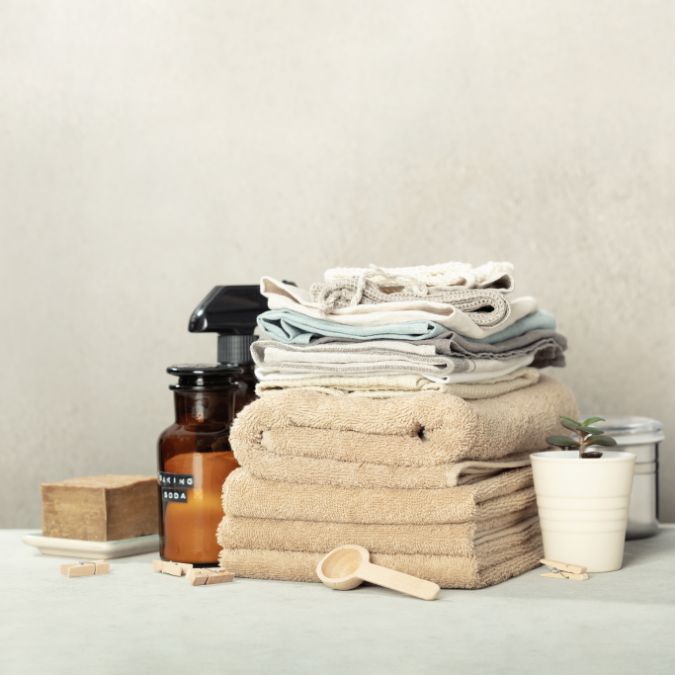Hello there! Ready to dive into the world of ultimate sheet freshness?
There's absolutely nothing that beats the feeling of slipping into perfectly clean and freshly laundered sheets. But let's face it, getting them to that ideal state of freshness isn't as simple as just throwing them into the wash.
Let's navigate this together, shall we? Your comfy and rejuvenating sleep is waiting on the other side.
The Basics of Bed Sheet Materials and Their Needs

Before diving into the nitty-gritty of how to wash bed sheets, it's essential to lay a solid foundation by understanding the various types of fabrics used in making bed sheets.
Each fabric type, from the popular cotton and linen to the luxurious silk and eco-friendly bamboo, has its own unique characteristics, benefits, and care requirements. The longevity and comfort of your bed sheets largely depend on how well you cater to the specific needs of the fabric.
Cotton Sheets
Cotton bed sheets, a worldwide favorite for their breathability and softness, have subcategories like Egyptian, Pima, and upland cotton. Delicate types like Egyptian cotton demand cooler water and gentle cycle, whereas others can handle warmer conditions.
Linen Sheets
Linen sheets, known for their substantial weight and high moisture-wicking properties, call for gentle handling. Cold cycle and air drying preserve linen's texture, luster, and durability.
Gauze sheets
Gauze bed sheets, known for their light and airy qualities, are suitable for hot weather or people who tend to sleep warm. These delicate fabrics should be washed with gentle detergents in cold water. Opt for a gentle cycle or hand wash cycle to maintain the integrity of the gauze fabric.
Polyester blends
Polyester, a synthetic material, can withstand warmer water and a variety of detergents, but to maintain color and texture, avoid using bleach and high-heat drying.
Silk sheets
Silk sheets epitomize luxury and smoothness. They require meticulous care in washing. Hand-wash bed sheets made of silk in cold water and using specialized silk-friendly detergents are ideal for maintaining their integrity.
Bamboo sheets
Bamboo sheets call for cold water and gentle cycles with mild or bamboo-specific detergents, ensuring the preservation of their soft texture and antibacterial properties.
Satin sheets
Satin sheets, made from polyester or silk blends, demand care akin to silk. Washing satin sheets and silk ones require gentle washing, cold cycle, and air drying preserve the sheen, smoothness, and quality of satin sheets.
Blends
Blended sheets, often a combination of cotton and polyester, we suggest washing with lukewarm water and regular detergents.
The Step-by-Step Guide to Washing Bed Sheets
Now that we have an in-depth understanding of different types of fabric and their unique care requirements, it's time to get our hands wet, literally and understand what settings to wash bed sheets are needed!
Here is a step-by-step guide to wash bed sheets of all types. Understanding the general process is essential, and from there, we can adapt it to different fabric types as needed.
Step 1: Sorting Your Sheets
Sort sheets by color and fabric type. Different fabrics have unique care requirements as seen above. When you wash your sheets, all sheets together, regardless of their material, can lead to damage and reduced lifespan. Keep delicate fabrics like silk and satin sheets separate from more durable types like cotton or polyester.
Step 2: Checking for Stains
Before washing your sheets, thoroughly inspect them for any stains. Pre-treat these spots with a stain remover or a homemade solution tailored for the specific fabric type. More on that later on.
Step 3: Loading the Washing Machine
Avoid putting too many sheets in the washing machine. Give your bed sheets ample space to move around for effective cleaning and rinsing. Washing sheets separately or with other lightweight linens of similar fabric types are preferable to ensure comprehensive washing and prevent fabric damage.
Step 4: Choosing the Right Detergent
Select a high-quality, mild detergent suitable for your sheet's fabric type. Avoid harsh detergents, especially for delicate fabrics like silk or linen, as they can break down the fibers, leading to wear and tear over time.
Step 5: Setting the Correct Temperature
So if you ever ask yourself what setting to wash sheets on? Well, it is simple. Set the water temperature according to the fabric type. Cotton and polyester sheets can generally be washed in warm water. In contrast, linen, silk, and other delicate fabrics should be washed in a cold cycle to maintain quality and prevent shrinkage.
Step 6: Selecting the Wash Cycle
Choose a gentle or medium wash cycle, especially for delicate bed sheets. For more robust materials like polyester, a normal cycle is suitable. The heavy-duty cycle should be reserved for heavily soiled sheets, ensuring to check fabric care instructions.
Step 7: Dry Sheets
Properly drying your sheets is crucial. Avoid over-drying as it can cause fabric damage and set wrinkles, especially in cotton and linen sheets. Line dry or use the lowest setting on your tumble dry. For delicate fabrics like silk, air dry away from direct sunlight to maintain their color and integrity.
Step 8: Folding and Storing
After drying, fold your bed sheets neatly and store them in a cool, dry place. Proper storage preserves the freshness and quality of your sheets, ensuring they're always ready for use, providing comfort and a soothing sleep environment.
Stain Removal Techniques for Different Fabrics

When it comes to keeping your bed sheets spotless, each fabric requires its own approach. Let's look at how to tackle common stains on various sheet materials.
Cotton and Cotton Gauze Sheets are quite forgiving. For oil stains, a bit of dish soap worked gently into the fabric before washing can work wonders. As for sweat stains, a pre-soak in warm water mixed with oxygen-based bleach is your best bet. This gentle treatment lifts stains without damaging the fabric.
Linen Sheets, known for their durability yet gentle nature, need a careful touch. Oil stains on linen can be addressed by dusting the area with talcum powder, which absorbs the oil. Brush it off gently before washing. Sweat stains on linen respond well to a pre-wash soak in lukewarm water with a mild detergent.
Silk Sheets: Silk is delicate, so treat stains with care. For both oil and sweat stains, lightly dab the area with a mixture of lukewarm water and a few drops of gentle detergent. Rinse with cold water and avoid rubbing, as this can damage the silk fibers.
Satin Sheets: Similar to silk, satin needs gentle handling. Use a soft cloth dampened with cold water and a mild detergent for oil and sweat stains. Pat the area gently and avoid wringing or twisting the fabric.
We care about building a quality product, trusted relationships with our customers, and a sense of community that connects our customers and team with one another.
Eco-Friendly Washing Practices
Embracing environmentally friendly washing practices benefits both your sheets and the planet. Using plant-based, phosphate-free detergents not only reduces the chemicals released into water systems but also is gentler on your sheets.
When it comes to water temperature, opting for cold water conserves energy and is usually sufficient for cleaning sheets, especially delicate ones like silk and satin.
And let's not forget about drying – air-drying your sheets is the most eco-friendly option. If you do use a dryer, select a low heat setting to save energy and protect your sheets from high-temperature damage.
Troubleshooting Common Sheet Issues

Keeping your bed sheets in pristine condition can sometimes be a challenge. Here's a deeper dive into solving some common sheet-related problems:
Color Fading
This can happen over time due to repeated washing and exposure to sunlight. To minimize fading, turn sheets inside out before washing. Use a detergent formulated for colored fabrics to protect the dyes.
When drying, avoid direct sunlight which can further fade colors. Instead, opt for air-drying in a shaded area or use a low heat setting on your dryer.
Pilling
Pilling is those tiny balls of fiber that can form on sheets, often due to friction during washing and wearing. To prevent this, wash your sheets separately, especially from clothing with zippers or hooks that can cause friction.
Using a gentle wash cycle is key. If pilling has already occurred, a fabric shaver or a lint roller can gently remove the pills and restore the smooth feel of your sheets.
Fabric Stretching
This usually occurs from aggressive washing or drying cycles. To maintain the integrity of your sheets, avoid high spin settings in the washer.
When drying, it's best to air-dry your sheets or use a low heat setting. Over-drying in high heat can not only stretch fabrics but also weaken fibers over time.
Shrinkage
Natural fibers like cotton and linen are prone to shrinkage, especially with the first few washes. To mitigate this, wash your sheets in cold or lukewarm water.
Avoid using hot water, and when it comes to drying, either air-dry or use a low heat setting. If you must use a dryer, consider removing the sheets while they are still slightly damp to air-dry the rest of the way.
Rough Texture Over Time
Over time, sheets can lose their softness. To keep them feeling soft and comfortable, use a mild, fabric-softening detergent. Alternatively, adding a cup of white vinegar to the rinse cycle can naturally soften fabrics without leaving a residue. Avoid overuse of fabric softeners, as they can build up on the sheets and reduce their breathability.
When to Replace Your Sheets

Maintaining the quality and comfort of your bed sheets is essential for a good night's sleep. One key aspect of this is knowing when it's time to replace them.
Sheets that show signs of wear, such as thinning material, persistent stains, or holes, are clear indicators that they need to be replaced. Similarly, if your sheets have lost their vibrant color or have become rough and scratchy over time, they no longer provide the comfort they once did.
Fitted sheets that have lost their elasticity and no longer fit snugly on the mattress also contribute to a less comfortable sleep experience and should be replaced.
The frequency of replacing your sheets depends on several factors, including the material quality and how well they are cared for.
Generally, it's advisable to replace bed sheets every two to three years, although some high-quality materials like Egyptian cotton or linen may last longer with proper care.
Regularly inspecting your sheets for signs of wear and tear can help you determine the right time for replacement. This not only ensures a comfortable sleep but also maintains the aesthetic appeal of your bedroom.
Additionally, for those with allergies, replacing sheets more frequently can be beneficial. Older sheets can accumulate dust mites and other allergens, which might cause allergic reactions such as sneezing or itching.
Upgrading your sheets can thus also be a step towards better health.
In conclusion
Replacing your bed sheets when necessary is a simple yet effective way to enhance your sleeping environment, ensuring both comfort and hygiene.










